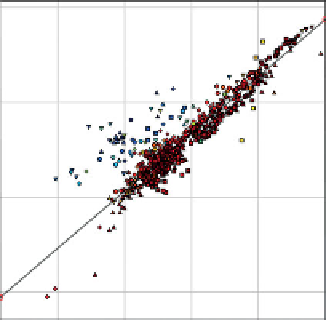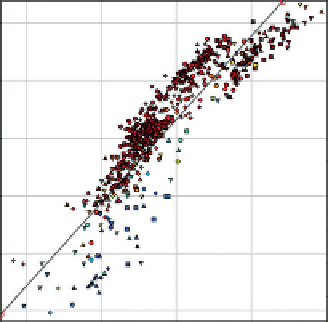Geology Reference
In-Depth Information
a)
b)
5623.41
V
sh
2.548
0.9
2.458
0.8
4216.97
0.7
2.371
0.6
0.5
0.4
2.288
3162.28
0.3
0.2
2.207
0.1
2371.37
2.129
Acoustic impedance (m/s.g/cc)
Acoustic impedance (m/s.g/cc)
Figure 9.25
Background trends for constraining simultaneous inversion; (a)
AI
vs density and (b)
AI
vs
SI
plotted on log
log axes
-
(courtesy Ikon Science).
terms of the AVO equations, density reflectivity is a
relatively minor effect and only becomes important at
far angles where there tends to be significant noise
and uncertainty in the interpretation of the amplitude
signature. If it is at all possible to extract density
information from seismic, very good data are
required with incidence angles beyond 40°.
smoothing inherent in deterministic inversions is
also an issue that can cause both bias in volume
calculation and errors in mapped connectivity in res-
ervoirs with
'
thin
'
beds (Francis,
2006a
; Sancervero
et al.,
2005
).
Figure 9.28
illustrates the issue with a logged
section of a thin bedded reservoir in which the ori-
ginal log (
Fig. 9.28a
) is upscaled to the seismic scale
using a Backus average calculation (note that the sand
is shown in blue). It is evident that the upscaled log
(
Fig. 9.28b
) cannot be used to reliably predict the pay
in the reservoir. If the threshold determined from the
logs is applied to the upscaled log the net sand will be
under predicted. In practice the interpreter faces a
number of issues that can make it difficult to be
precise about impedance calibration. For example, it
is unlikely that an absolute impedance inversion will
recover the Backus averaged log exactly owing to
problems in removing tuning effects, and this can
potentially offset the negative effects of smoothing.
The more wells that are available, the better the cali-
bration can be understood. Certainly the interpreter
should be aware that predicting net sand from thin
zones with deterministic inversions is likely to be
prone to an unpredictable bias.
Connectivity is another issue that is affected
by smoothing.
Figure 9.29
from Francis (
2006a
) illus-
trates how smoothing applied to a structure map has
9.2.8 Issues with quantitative
interpretation of deterministic inversions
Because the seismic trace is bandlimited, there are a
large number of impedance models which when con-
verted to reflectivity and convolved with the wavelet
would give a satisfactory match to the seismic traces.
The inversion methods discussed so far can produce
only a blocky average impedance solution. They will
work best where the subsurface contains fairly
'
layers (so that the lack of high frequencies in the
seismic data is not important), and where the layering
is conformal with limited lateral variability, so that
the low-frequency model can be established from
limited well control.
As illustrated in the previous discussion there is
considerable potential for bias to be incorporated
into the inversion results, particularly through the
low-frequency model (i.e. the DC component of
the impedance). In addition to this, however, the
'
thick
213














































